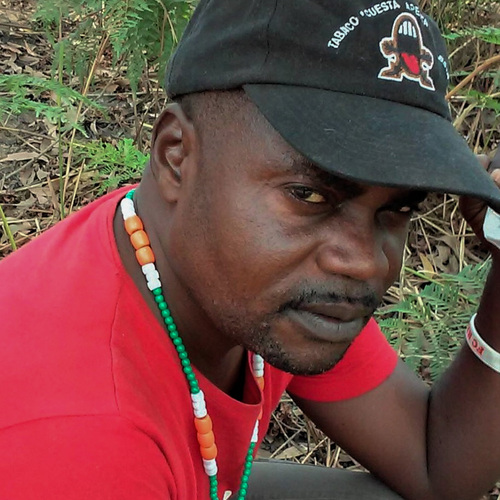Franklin Mbungu Wabonga

Francklin Mbungu was born in 1972 in Kinshasa (DRC) where lives and works.
Son of an antiques dealer who opened him to the world of art and culture, Mbungu was introduced to painting by three artists who came to paint regularly in his father's shop. Although it is undeniable that he has kept retained traces and probably technical rudiments from this time, he could not flourish in this direction.
He began his professional life as a manager for other Congolese artists. After a few years of practice, Mbungu decided to become an artist himself.
As he himself says, one day, in a prayer addressed to God, Mbungu vowed to become an artist, but a different and recognizable artist among all artists. It is then that in a vision, that colored sheets, scissors and razor blades clearly appeared. Mbungu exchanged his paint for glue.
Very different from traditional Congolese folk painting, which we know well, he cuts, assembles, folds, superimposes layers of paper, glues them with exceptional dexterity, and adds colored threads, ribbons and wrapping paper, thus creating almost three-dimensional works. We can take pleasure in finding characters, flowers and objects that all spring together to tell a story…their story.
This astonishing technique, which Mbungu claims he is the only one to practice in his city, allows him to create scenes where the tactile and visual sensations of volumes dominate. Because any material can be used to complete, highlight, emphasize and dress his paintings;v papers and fabrics, of course, but also a host of different materials (chains, strings, ribbons of all colors and all etc.) abundant and brilliant, the changeability of which contributes to the expressionism of his works. Through this sometimes confusing approach, he creates vibrant and colorful portraits of his Congolese compatriots, including the iconic “sapeurs".
Francklin MBUNGU is inspired both by the daily life and the mythology that permeates the experience of all Congolese, including the siren which is one of his recurring themes. His world is dreamlike and flamboyant. Very much marked by the aesthetics of the seventies, Mbungu often dresses his male characters in wide pants of multicolored elephants, shirts of garish colors and extravagant bow ties. As for women, they wear dresses and colorful headdresses that often showcase the shapes and textures of their hair. Francklin MBUNGU likes to represent street musicians, dancers in action or getting ready to go out to party.
In only a few years, this original artist has acquired a form of international recognition that has already given him exposure in many parts of the world, in particular:
• In 2016 in Mauritius, he exhibited in When Africa Meets Mauritius: Africa Bomoko;
• In 2017, one can appreciate his works in Au Monde des Flamboyants, Kinshasa (DRC), Trust Merchant Bank SA ;
• In 2018, he is in Hong Kong in the exhibition Francklin Mbungu & JC Lofenia, African Coffee & Tea;
• Finally, in 2018/2019, we see it and we notice it in Kinshasa Chroniques, Sète (France), MIAM (International Museum of Modest Arts).
It is certain that his way of doing things could only please Hervé DI ROSA, famous founder and promotor of this institution (MIAM) which privileges this appropriation of insignificant pieces to give them "a second chance" by becoming works of art!
King of collage, Francklin MBUNGU offers us works that are cheerful, festive and colorful; they have rhythm, mixing La Sape and rumba of Cuban inspiration and are a reflection of the nightlife of Kinshasa.
Henri MATISSE was the Western painter who handled with the utmost virtuosity the technique of glued paper and gave him his pedigree, but even if there is a relative technical commonality between the two artists, we can not speak of resemblance, inspiration and even less plagiarism. This work has no intellectual pretensions, it is content to be fresh and pretty and it’s impact is already huge because more and more contemporary art is moving away from the criteria of simplicity, accessibility and beauty; quite simply, that he should never totally lose sight of. Simplicity is not oversimplification, hidden under a misleading ease, beyond the technical virtuosity already evoked, is a vision of Kinois society; that of the street, that of the night, that of gaiety and the feast that hides the existential, sometimes elementary problems, which affect all African societies, under an apparent joy of living.
By making us dance and swirl to lose our breath, to lose consciousness, Francklin MBUNGU helps us to forget the present, far from our human condition, a moment of absence, and he makes us all feel very good.
Sylvain Sankalé
Dakar
December 2, 2019
Read More







